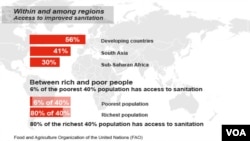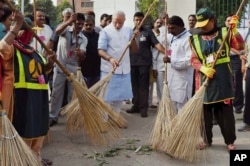India is racing to build toilets by 2019 for 600 million people or roughly half the population which lacks access to sanitization. Prime Minister Narendra Modi has put it high on the national agenda, but the challenge could be daunting in a country where defecating in the open is a common sight and is accepted by many as normal.
A giant 700-kilogram cake shaped like a toilet, a walk-a-thon and pledges by hundreds of students to join a sanitation drive marked a three-day event in New Delhi (Nov. 18-20) billed as International Toilet Festival.
It was held to observe World Toilet Day. It is a day that got more attention than ever before, thanks to a massive campaign launched by Modi last month (Oct. 2) to provide toilets in every home.
School students like Diksha sound enthusiastic about the drive, which also focuses on cleaning up towns and cities where garbage lying in streets is a common sight.
“I want you all to be encouraged, get motivated by all these people who are here, including me and my friends, not to pollute the environment and to create toilets where ever possible,” said Diksha.
The event was organized by Sulabh International, an India-based social organization that has been working to improve sanitation.
Danger in the field
Lack of access to toilets has been identified as a huge problem, particularly in rural India. It not only spreads diseases like diarrhea but also exposes women to the risk of sexual assault when they go into the fields after dark. A World Bank study estimated that poor sanitation could be costing India $54 billion in treatments for illnesses, early deaths and lost productivity.
Health experts however say the challenge is more complex than one of just providing toilets.
In villages, there is often huge resistance to using them, partly due to age-old cultural associations of latrines in, or near, the home with ritual impurity.
A study by Diane Coffey, a visiting researcher from Princeton University, indicated that 40 percent of 3,200 households surveyed in northern India reported that even in homes with a latrine, at least one member preferred to use the fields. Speaking to VOA from the rural Sitapur district in Uttar Pradesh where she is working, Coffey called this a wake-up statistic.
“Open defecation, unlike in other places, where it has a negative connotation, here it is something that is completely normal, and even sometimes wholesome, like the fact that you have gone for a morning walk, and you have exercised your body and you have gotten up early. These are all signs of vigor and strength,” she said.
However, Modi and organizations like Sulabh sound optimistic that the target can be achieved.
Sanitation campaign
While launching his cleanliness campaign last month, Modi urged the country to turn the drive into a social campaign.
He said it takes time to change old mindsets and habits, and is a tough task. But if everyone joins hands to make it a mass movement, then India too will be counted among the world’s clean countries.
A beginning has been made with social organizations like Sulabh and several corporations and even celebrities vowing to give momentum to the campaign.









